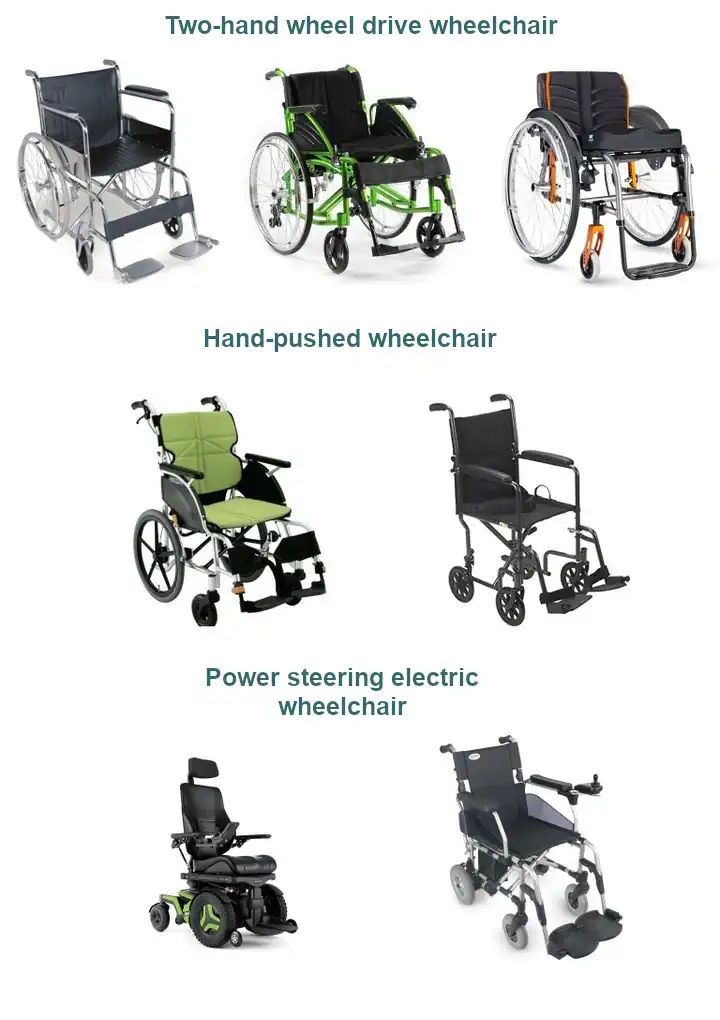To be honest, when I looked at the types of wheelchairs introduced in books on rehabilitation and assistive devices, I found that most of them were lists of types of products. Although the multi-dimensional classification is comprehensive and the product illustrations are intuitive, I was confused after reading them and was not sure what type of wheelchair should be used for what kind of people, which is a slight pity.
So, we are ready to change our thinking about the types of wheelchairs.
The traditional classification of wheelchairs is mostly derived from the international standards of assistive devices, which are accurately positioned and comprehensive. Manual and electric are separated on both sides, with secondary subdivision to twelve categories. This classification is based on the way the wheelchair is driven, and there are two advantages to this classification.
One is that it addresses the most basic needs of wheelchair users.
Secondly, it covers all wheelchairs product types in the existing market. With this classification method, it is not a dream to have a one-stop service for intelligent coding and adaptation of products.
However, in the process of adaptation over the years, we have also found that there are some problems with this classification in practical application. Because of the high level of this classification, the specific functions of wheelchairs are not clear from the classification alone, and practitioners are often at a loss to carry out configuration services based on it.

There is a wide variety of wheelchairs products on the market, and those of you who have been to the exhibition must have had the profound experience of being dazzled. But are the various types of products evenly distributed?
The answer is certainly …… unbalanced!
We checked the European wheelchairs authority EASTIN wheelchair product database information and found that only four major products are dominant, which are dual wheel drive wheelchairs, push wheelchairs, power steering electric wheelchairs and manual steering electric wheelchairs.
Intuitively, specifically in terms of structural function and structural form, wheelchairs can be thought of as seven subcategories of wheelchair vehicles covered by three major product categories (see below).

The seven types in the chart above are the main types of wheelchairs you will see on the market, in institutions, and in your life. Once we understand the common types of wheelchairs, we are one step closer to wheelchair selection. If you or a family member is a heavy wheelchair user, we recommend that you go through a professional wheelchair selection process anyway, with professional assistive technology counselors, well-known rehabilitation hospitals and assistive technology services being good choices.
So, how exactly do you choose a model?
The primary factor to consider is “how to implement”. The power source for pushing is either your own, someone else’s, or a machine. Most users use both upper limbs to push the wheelchairs, but what if only one upper limb works? There are also easy-to-use one-handed pushchairs available. What if both hands can’t be used? Then consider a bipedal wheelchair with a low seating surface.

Fixed frame wheelchairs, lightweight frame wheelchairs and active wheelchairs are the most widely used types of dual upper limb drive wheelchairs on the market today. For users who can sit upright and have full mobility in their lower extremities, fixed frame wheelchairs and light frame wheelchairs are good choices. Light frame wheelchairs are usually lighter and easier to implement, but are relatively more expensive.
For users with higher mobility needs and good seating posture, active wheelchairs can provide more effective propulsion efficiency and more flexible pushing operations. It should be added that active wheelchairs require higher control of one’s body balance, and the advantages of flexibility come with the risk of backward tilt, which is not recommended for older adults.

So, which type of wheelchairs is more suitable for the elderly?
It must be said that the rapid aging process in China has objectively promoted the application of care wheelchairs. I have visited many elderly care facilities and found that wheeled walkers and care wheelchairs are very widely used. Care wheelchairs are wheelchairs that do not have handwheels and are pushed by caregivers on the back side of the seat. Their smaller rear wheels and simple structure make the process easier.
To be honest, I’m afraid to use a light frame wheelchair with cognitive impairment because of the danger of the elderly having nowhere to put their hands to get caught in the spokes of the large wheels. Of course, for temporary transfers, the simpler transfer wheelchair is easier to use, and the width of the transfer wheelchair allows for smooth passage through the doorway and for maneuvering around the restroom.

Anyone with wheelchair needs must have wondered the question, “Do I choose an electric or manual wheelchair?”
To answer this question, we just need to figure out what kind of people are not suitable for electric wheelchairs. The electric wheelchairs on the market now are so powerful that people with hand control can be equipped with electric wheelchairs, except in cases where it is unsafe to operate an electric wheelchair due to cognitive impairment. Many injured people use manual wheelchairs at home and in small areas, and choose electric wheelchairs when traveling long distances. As long as the budget is sufficient, electric wheelchairs can lie flat, stand, and tilt with all the functions.
Since electric wheelchairs are so strong, is it good for everyone to choose an electric wheelchair. Price aside, why do many people still choose manual wheelchairs? As the old saying goes, “If you don’t use it, you lose it”, and proper exercise helps maintain health. Besides, an electric wheelchair is a dragon when it has electricity, and a worm when it doesn’t. How to choose, and depends on the comprehensive consideration of personal will.
